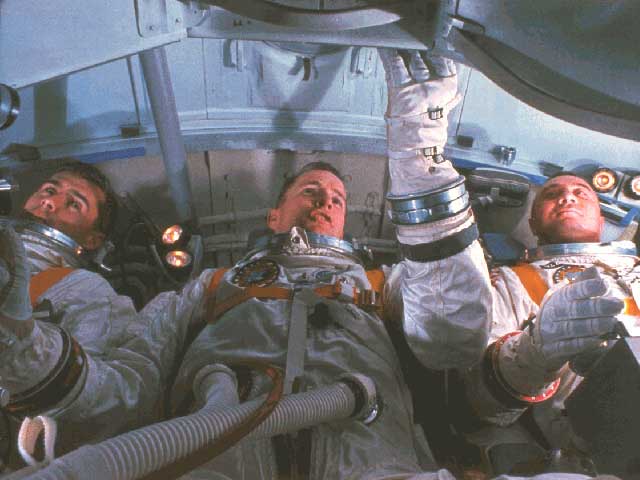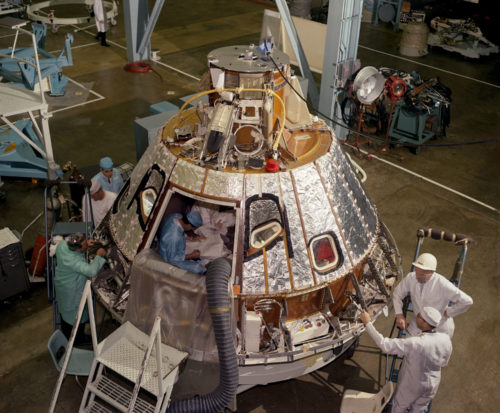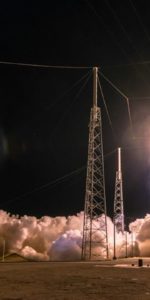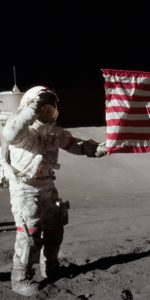
In the windowless blockhouse at Pad 34 at Cape Kennedy, Deke Slayton heard the call of “rookie” astronaut Roger Chaffee and glanced over to a monitor which showed the hatch window of the Apollo 1 Command Module (CM). It was Friday, 27 January 1967, and Chaffee and his crewmates—Command Pilot Virgil “Gus” Grissom and Senior Pilot Ed White—were sealed inside the spacecraft, atop its unfueled Saturn IB booster, performing a “plugs-out” systems test. As outlined in yesterday’s AmericaSpace history article, the test had been repeatedly postponed through the afternoon, due to niggling technical glitches.
Now, as the normally dark hatch window turned white, Slayton realized that something drastically abnormal was occurring. At 6:31 p.m., Chaffee called “Fire” and, within seconds, further frantic calls emanated from Apollo 1. “We’ve got a fire in the cockpit,” Chaffee yelled. “Let’s get out. We’re burning up!” Finally, there was a blood-curdling shriek.
On the first floor of Pad 34, technician Gary Propst could clearly see Ed White on his monitor. The astronaut’s arms were raised over his head, fiddling to open the CM’s heavy, two-piece hatch. Propst could not understand why the men did not simply blow the hatch, little realizing that its inherent design made this impossible. White had to use a ratchet to laboriously release six bolts spanning the circumference of the inner section of the hatch. Years later, astronaut Dave Scott—who had trained as White’s backup between March and December 1966—wrote in his autobiography, Two Sides of the Moon, that during training, he and White weightlifted the hatch over their heads whilst lying supine in their Apollo couches. Now, in the few seconds he had available before being overcome by smoke, White barely had chance to begin loosening the first bolt.

Tragically, it made little difference. In normal conditions, it would require 90 seconds at best, and even the super-fit White had been unable to do it in less than two minutes during training. However, fire was gorging Apollo 1 and the accumulation of hot gases sealed the hatch shut with tremendous force. No man on Earth could possibly have opened the hatch under such circumstances.
Investigators would later discover that the fire began somewhere under Gus Grissom’s seat, on the left side of the cabin, perhaps in the vicinity of some chafed and unprotected wiring. Once sparked in Apollo 1’s pure oxygen atmosphere, it fed hungrily and quickly exploded into an inferno. Other combustible objects—including Velcro pads, nylon nets, polyurethane pads, and paperwork—fanned the flames. The astronauts themselves had taken a Styrofoam block into the cabin to relieve the pressure against their backs, but this exploded like a bomb in the pure oxygen. “At such pressure, and bathed by pure oxygen,” wrote Grissom’s biographer, Ray Boomhower, in Gus Grissom: The Lost Astronaut, “a cigarette could be reduced to ashes in seconds and even metal could burn.”
At length, pressures exceeded Apollo 1’s design limits and the conical capsule ruptured at 6:31:19 p.m., filling the Pad 34 white room with thick smoke. By now, the poisonous fumes had asphyxiated the three astronauts to death. Not far away, pad leader Don Babbitt sprang from his desk and barked at lead technician Jim Greaves to get the three men out of the spacecraft. But it was hopeless. The waves of heat and pressure were so intense that the would-be rescuers were repeatedly driven back. “The smoke was extremely heavy,” Babbitt later recalled. “It appeared to me to be a heavy thick grey smoke, very billowing, but very thick.” None of the pad crew could see far beyond the end of their noses, and they had to run their hands over the outside of the Saturn IB boost cover to find holes into which they could insert tools to open the hatch.
No less than 27 technicians were treated that evening by the Cape’s dispensary for the effects of inhalation. Don Babbitt had to order Jim Greaves outside at one point, lest he pass out. Firefighters eventually opened the hatch and the would-be saviors beheld a hellish scene of destruction.
By the flickering glimmer of a flashlight, they could see little but burnt wiring and an incinerated interior. According to firefighter Jim Burch, it took a few seconds before the ethereal calmness convinced them that Grissom, White, and Chaffee were gone. It was 6:37 p.m., barely 5.5 minutes since Chaffee’s initial shout. America’s dream of landing on the Moon before the decade’s end was in tatters. Choking over the phone to Deke Slayton, Babbitt could not find the words to describe what he saw.
Slayton and flight surgeon Fred Kelly arrived at the base of Pad 34 a few minutes later. They realized that it would take hours to remove the dead men from Apollo 1, because the heat had caused everything to melt and fuse together. Moreover, there remained a very real risk that the heat could accidentally trigger the Saturn IB’s escape tower and the pad was cleared of all personnel. Not until the early hours of 28 January 1967 were the bodies removed. None of them had suffered life-threatening burns and all had died from asphyxia when their oxygen hoses burned and their suits rapidly filled with poisonous smoke.
In his autobiography, Deke, Slayton described it the “worst day” of his career, and even the normally teetotal astronaut Frank Borman admitted that he went out and got drunk after the accident. “I’m not proud to admit it,” Borman once said, “but … we ended up throwing glasses, like a scene out of an old World War One movie.” The wives of the three dead men—Betty Grissom, Pat White, and Martha Chaffee—later sued North American for its shoddy spacecraft. Each received hundreds of thousands of dollars in compensation in 1972.
For Project Apollo, almost two years would elapse before three astronauts would board the spacecraft in October 1968 and complete its first piloted flight in low-Earth orbit. By then, the mighty Saturn V booster had also been put through its paces and, over the course of the following months, America would deliver Apollo to lunar orbit and conduct a critical series of steps which enabled Neil Armstrong, Mike Collins, and Buzz Aldrin to accomplish humanity’s most exalted goal in July 1969. Two years later, in the summer of 1971, as he completed the last of his three Moonwalks, Apollo 15 Commander Dave Scott laid a small aluminum figurine and plaque on the lunar soil.
It bore the names of all the known U.S. astronauts and Soviet cosmonauts who had died whilst advancing our future in space. The list included 14 names, including fallen Gemini IX pilots Elliot See and Charlie Bassett, the world’s first human spacefarer, Yuri Gagarin, and the recently-deceased trio of cosmonauts from Russia’s ill-fated Soyuz 11 mission to the Salyut 1 space station. And within that list were the names of Apollo 1 Command Pilot Virgil “Gus” Grissom, Senior Pilot Ed White, and Pilot Roger Chaffee: three men whose lives were cut short in their prime, who had already forged names for themselves—including America’s first spacewalker—and who might, had circumstances been different, have ended up planting their own bootprints into the lunar regolith.
This is part of a series of history articles, which will appear each weekend, barring any major news stories. Next week’s article will remember the anniversary of the Challenger accident on 28 January 1986, when the seeming infallibility of the space shuttle was changed forever.
Want to keep up-to-date with all things space? Be sure to “Like” AmericaSpace on Facebook and follow us on Twitter: @AmericaSpace






It Is Still A punch In the Gut…RIP Apollo 1
Excellent 2-part article. Thank you, Ben!
Fine article. Very sad how NASA stores the remains of Apollo 1 and how Pad 34 is allowed to decay. Also very tragic about what happened to Pat White. NASA should release more documents and photos from the accident.
“Pad 34 is allowed to decay”
The Florida Atlantic coast is one of the most corrosive environments on Earth. NASA’s facilities maintenance budget is perpetually stretched thin, spending $100,000 + dollars annually to perform corrosion mitigation on the “abandoned in place” pad 34 would not be a wise investment.
Some sort of large enclosure/museum over the pad would be nice, but only if it were privately funded somehow. What with the relatively low tourist traffic out to that pad, that’s not likely to happen.
For more information on the agency’s vital (and ignored by the public) corrosion control efforts, visit the website for the KSC Corrosion Technology Laboratory: http://corrosion.ksc.nasa.gov/
There’s so many things I can say, but I’ll be simple about it:
“Ad Astra Per Aspera
Per Ardua Ad Astra
Res Gesta Par Excellantium
Ex Luna, Planeta, Astra, Scientia
Semper Exploro
Ad Inexplorata”
Preserving the site should be a goal of the Apollo 1 foundation.
The foundation has done what they can as small 401c on a shoestring budget, but with each passing day, nature is reclaiming the pad.
The lasting tribute to the Apollo 1 crew is resting at Apollo 15’s Hadley-Apennine landing site on Luna.
And this Friday I will be reaffirming yet again my pledge to Roger Chaffee.
Pardon me for asking but could you share your pledge?
I’ve avoided a set formula because I don’t want it to become a rote recitation. But basically I just tell him I know he deserves to get to fly in space, and promise that we will develop the necessary technologies to make it possible.
It’ll probably involve developing the processors, chipsets and software to run human consciousness on a machine substrate, although hopefully it won’t also involve his being hounded to the launchpad by Luddites like in The Crime and Glory of Antonia DeVilbiss and Phoenix Dreams.
One Tragic Legacy of Apollo 1 is that Joe Shea, a Senior Engineer with North American Rockwell, the Prime Contractor for the Apollo Spacecraft, was somewhat skeptical of the Prime and Basic Crews complaints about the Spacecraft and was invited by Gus Grissom to sit in the Lower Equipment Bay [LEB]on the January 27th launch simulation. NASA Techs were informed of this but could not rig a communications headset for Shea, who stated, “If you think I’m going to sit there for four hours or longer and not be able to talk to anyone, you’re badly mistaken.”
After the Fire, what happened next was kept within NASA, but after his passing, it was revealed that Deke Slayton had felt deep regret that he had not volunteered to sit in the LEB on January 27th, communications or not, since he felt that if he had been there, he might have seen the Fire starting and might have been able to stop it before it got out of control.
Astronauts and other NASA Personnel ALWAYS let Deke know the Reality, “If you had been in there, the only thing that would have happened is that we would pulled four dead Astronauts out instead of three.”
Sadly, Deke went to his grave believing that he could have saved the Crew. Only God could have saved them, but since the Engineers and technicians knew what they were doing, or SUPPOSED to know, they produced a slip shod excuse for a Manned Lunar Spacecraft and the Good Lord allowed such a Tragedy so that the Right Way would be seen and done.
The Crew of Apollo 1 did not die in vain. They caused numerous changes that were needed and not only did America get the First Man on the Moon, Buzz Aldrin, as he headed back up the ladder into the LM at the end of the EVA, reached into a pocket on his LEVA, pulled out a small pouch and dropped it to the lunar surface at Tranquility Base.
In the pouch were an Apollo 1 Mission Patch, Medals awarded to Soviet Cosmonauts Yuri Gagarin and Vladimir Komarov and a gold olive branch. Yuri Gagarin was the First Man in Space on April 12, 1961 and Vladimir Komarov, Gagarin’s Friend back up on the Soyuz 1 Mission, was the First man to be killed in an actual Spaceflight on April 24, 1967. Both were awarded the Order of Lenin, the Highest Award the USSR had and the Widows of each Cosmonaut asked the Soviet Foreign Ministry to give their Husbands Medals to the American Ambassador in Moscow, who then sent them to Washington where they were sent to Cape Kennedy and the Apollo 11 were instructed to leave them on the Moon.
In my viewpoint, the Apollo 1 Mission Patch DID fly and the Crew of Grissom, White and Chaffee made it to the Moon.
It’s interesting that you regard the atronauts’ names having been taken to the Moon is equivalent to the astronauts themselves traveling to the Moon. It hearkens to many Bronze Age civilizations that equated the name with the person (we see it in many passages of the Old Testament). Julian Jaynes’ theory suggests that it is a linguistic reminder of the bicameral mind which has persisted in the age of the introspective consciousness.
I don’t believe the astronauts died in vain. Instead, I don’t believe that it is necessary for them to remain dead on an ongoing basis after technology un-finals death. It’s not like an eldritch portal is going to pop open the minute the programmers boot up Roger as an infomorph and God’s going to whip out a tentacle to grab back the Apollo lunar landings because one of the men whose lives paid the price for it isn’t dead any more. It’s not a commercial transaction where the product has to go back to the seller to get the money back. And it’s very clear to me from all the interviews with Roger, especially the one right before the Fire, how much he’s looking forward to getting into space, so I’m just pledging to help him fulfill that desire.
In the Toni DeVilbiss cycle, seeing the picture of the astronauts praying over the model of the Apollo command module is a big part of how Toni becomes a deist. Her immediate reaction is that any god who wouldn’t answer their prayer had to be either an incompetent or a complete ogre. But she was already studying physics and recognized the elegance of equations such as F=ma and E=mc^2, so maltheism (Lovecraftian or otherwise) wasn’t an option for her. But suppose the Creator wasn’t a person with thoughts and feelings who could answer prayer? Having learned about deism through the lives of Newton, Franklin, et al, she realized just how much sense it made. The Deity wasn’t a Big Daddy in the Sky who arbitrarily granted or withheld favors (like some of the adult authority figures she had to deal with), but the principle that set the initial parameters of the universe and started the system running.